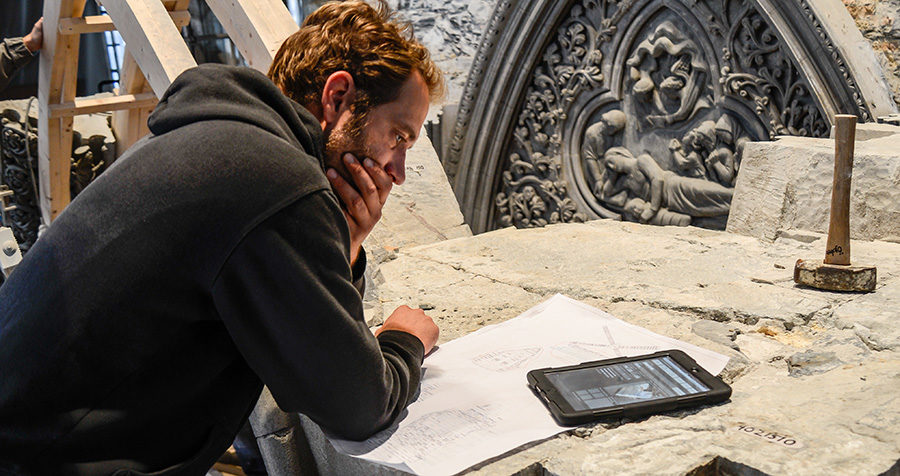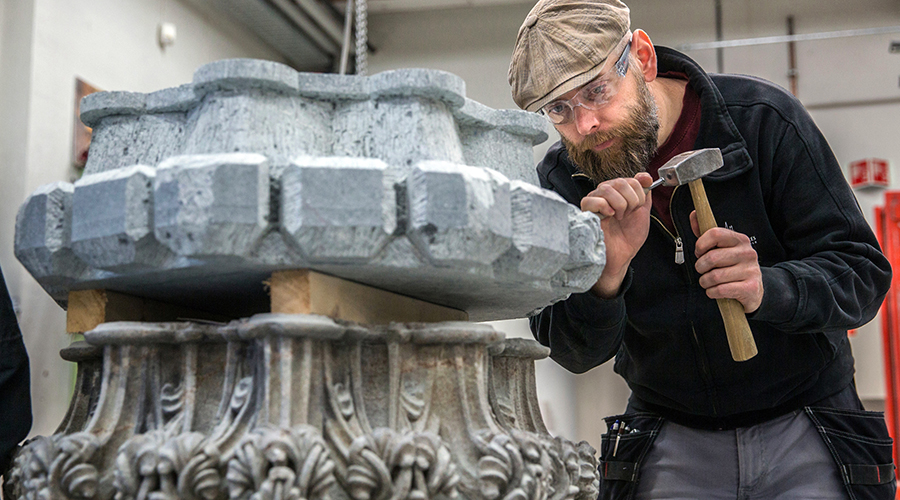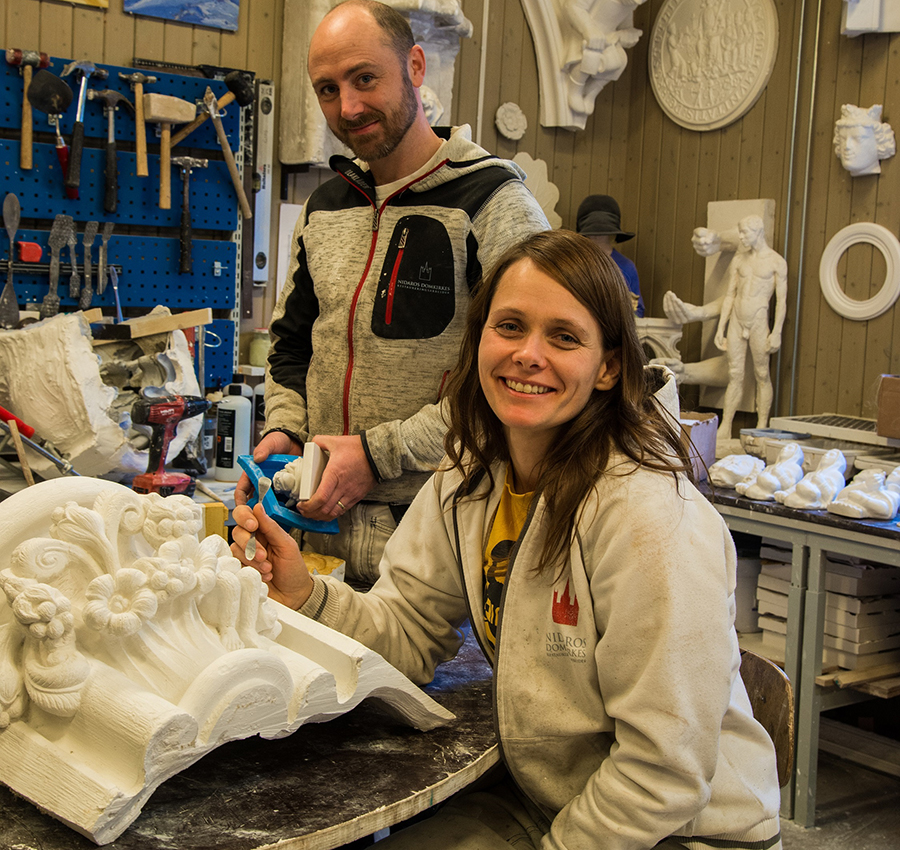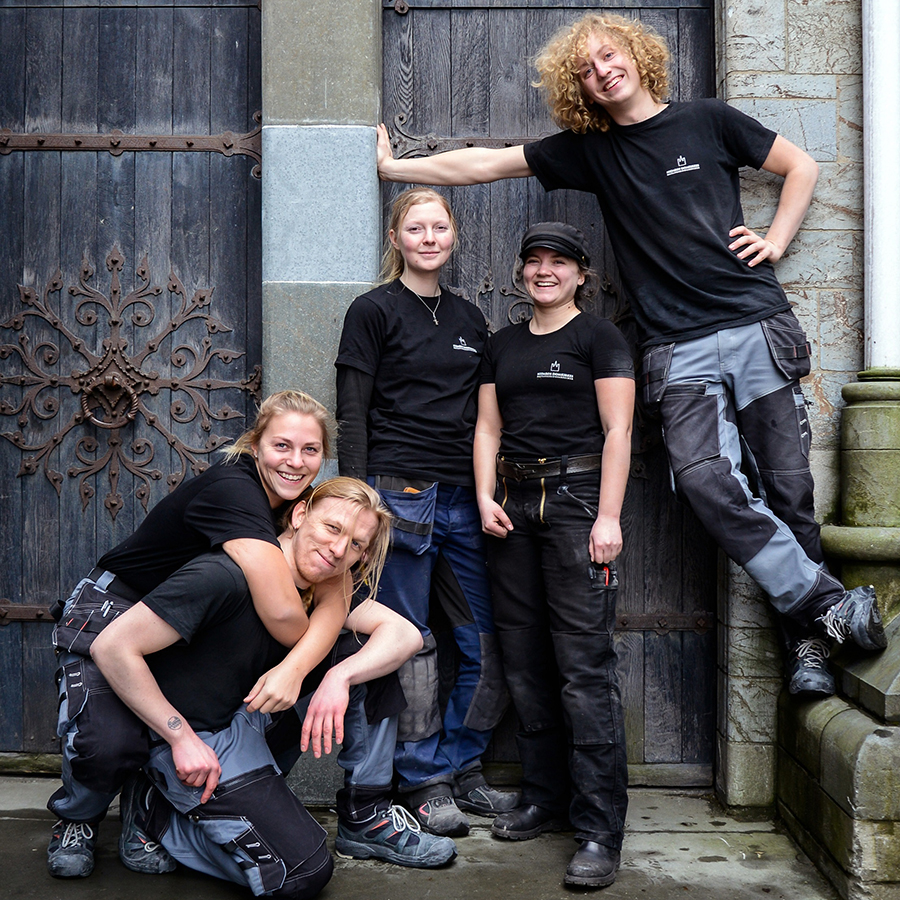Cathedral workshops- keeping the practice alive

Background
A building workshop, Bygghytte in Norwegian and Bauhütte in German, has been a way of organizing cathedral building works in Europe since medieval times.
The term Bygghytte covers both the organization, planning and building performance, and the offices, workshops and building yards.
This practice has now been inscribed in the Register of Good Safeguarding Practices of UNESCO Intangible Heritage by Germany, Austria, France, Norway and Switzerland.
The tradition spans over centuries and is alive in Norway today at Nidaros Cathedral Restoration Workshop. It all began in the Middle Ages with the German Bauhüttenwesen, an organization on the construction sites of European cathedrals, where action-borne knowledge was transmitted from the masters to the apprentices. Since the end of the Middle Ages, these workshops, which maintain close links with one other, have formed a network extending beyond national borders.
Restoration workshops are still connected to many of the cathedrals in Europe. Strasbourg cathedral workshop is the one with the longest known continuity, from the 12th century.
Nidaros Cathedral Restoration Workshop
Nidaros Cathedral Restoration Workshop is the oldest and the only one still working in the Nordic countries. It was established in 1869 to restore Nidaros cathedral. A new workshop is under establishment at Stavanger cathedral under guidance from the Nidaros workshop.
It is essential that the restoration workshops are situated in immediate proximity to the cathedral itself.
All the cathedral restoration workshops have a staff representing various crafts, such as stone carvers, masons, blacksmiths and glassworkers. They work in close connection with specialists in the fields of monitoring, research and planning. The continuity and the close interdisciplinary correlation and cooperation has made the restoration workshops a success in preserving these large medieval constructions.
Restauration and communication
Since 1869 the Nidaros workshop has also taken over responsibility for the restoration of the Archbishop’s Palace. Today the organization employs about 70 people. Some work on the restoration of the cathedral, while others organize exhibitions, guided tours and other activities for the close to 500 000 people who visit the historic site each year.
How it was done
National Centre for Restoration – Interdisciplinary knowledge
The Restoration Workshop of Nidaros Cathedral is a government appointed national center for the conservation and restoration of historically significant stone buildings. In addition to restoring the cathedral and palace, the skilled workers maintain and develop the traditional craft practices that their workshops represent. Several of these crafts are among the small and vulnerable ones in Norway. The experienced staff teach and share their skills with the apprentices. Interdisciplinary knowledge has always been of great importance at the workshop, and this type of traditional education is still a source of great pride amongst the employees. Today, this training is combined with a bachelor’s degree program in technical building restoration at The Norwegian University of Science and Technology (NTNU) and collaborate with research institutes and universities in Norway and in Europe.
The Restoration Workshop of Nidaros Cathedral provides:
– General advice concerning the restoration of historically significant stone buildings.
– In depth reports discerning the present condition of historic buildings and advice on preventive measures needed to maintain their upkeep.
– Guidance from craftspeople within our fields of expertise and quotations for traditional restorative projects.
The Stone Yard
The stone carvers are the nucleus of Nidaros Cathedral Restoration Workshop. Like the rest of our craftspeople, their goal is to maintain and further develop their traditional working methods. They carve each stone using the same type of tools that have been used by their predecessors in England and on the continent since the 12th century.

Nidaros Domkirkes Restaureringsarbeider jobber med kongeinngangen.
The Mason Workshop
During restoration projects, the main task of the masons is to position each carved stone in its correct place. It is essential that the masons have a very good understanding of both the production and the use of lime-based mortars. Lime mortar was used before the cement mortar came on the market in the 19th century. The use of cement mortar in the restoration of Nidaros cathedral has caused damage to the stones in the construction and this type of mortar is no longer in use.
The Smithy
The manufacture of all the metalwork takes place in the smithy. The smiths create tools for the other craftspeople, and various helpful objects for different restoration projects. Production, restoration and preservation of hinges are important tasks for the smiths.
The Plaster Workshop
The plasterers create casts of the cathedral’s sculptures and ornaments which the carvers use to recreate the building’s historic decoration. The casts also help the cathedral workshop create a record of all the sculptures. This has been especially important since 1983, when parts of the Archbishop’s Palace burned down and the original plaster collection was destroyed. The plaster workshop also registers and documents stucco work in other historical buildings and produces reconstructions and make repairs.

Anne and Joseph Photo: Henning Grøtt/NDR
The Stained Glass Workshop
The glass conservators undertake all work associated with the care and protection of Nidaros Cathedral’s stained-glass windows. Most of the windows were created from 1908 to 1935 by the artist Gabriel Kielland. They were inserted into the window openings in such a way that the daily temperature fluctuations throughout the year have caused massive bulges in the glass. Thus, a large part of the glaziers’ work is to replace the original lead with a type which is more suitable to the Norwegian climate. The workshop is among the very few in Norway which restore stained glass.
The Carpentry Workshop
The carpenters perform diverse tasks at Nidaros Cathedral and the Archbishop’s Palace. Restoration and maintenance of the building structures is a large part of their work. They also perform various other tasks, such as construction of special scaffolds and production and repair of interior wooden designs. The carpenters have the traditional skills needed to selecting trees in the forest for special purposes (slow grown wood, heartwood and tared wood), and they deliver materials for restoration of medieval wooden buildings.
Documenting and researching
Nidaros Cathedral Restoration Workshop has kept archives since its foundation in 1869. The records help to secure knowledge about restoration decisions that have been made for more than 150 years, providing knowledge about challenges that may re-appear in the future.
The scientific monitoring and research are closely connected with the professional crafts performance in Nidaros Cathedral Restoration Workshop. The archaeologists, historians, architects and conservators at the Monitoring and Research Department continuously study developments closely to be able to prepare for necessary action in the future.
Traditional organization of important crafts
If we go to the origin of the notion Bygghytte it was used for the new large building constructions in medieval time. Even though the cathedral workshop do not plan and build new constructions in the old traditional way, but restore and maintain the cathedral and the Archbishops’ palace, the buildings size, the annual workload and the traditional methods used makes it easy to compare the organization with the traditional medieval building site.
Preserving, developing and sharing knowledge
The importance of traditional crafts performance and craft knowledge has generally been neglected as a source for research into both restoration and reconstruction of buildings.
The restoration of the cathedral is based on internationally accepted principles and methods. Scientific knowledge of history, building techniques and the use of materials and crafts performance is therefore of high importance to the work at the cathedral workshop.
The constant use of- and need for the traditional skills of the workers in the restoration of the cathedral, keeps the crafts performance active. It also inspires the workers to do research into the old techniques and their own crafts performance. They do their research by studying toolmarks and other mechanical traces, as well as the substance of the materials. In this way the cathedral workshop gain new knowledge both from the crafts and from the building itself. The workshop manage to keep both the crafts traditions and the working organization alive and, in the end, to keep the cathedral in good condition. The knowledge is shared and used in other restoration projects around the country when needed. It is like a beautiful symbiosis – the crafts and artisans caring of the cathedral and the cathedral keeping the traditional crafts alive in the workers.

Apprentices at the Bygghytte. Photo: Henning Grøtt/NDR
Key factors
1. Physical nearness
The building site is in the immediate vicinity of the Nidaros Cathedral.
2. Nearness between the different crafts
Every traditional crafter is introduced to the other crafts and professions at the site. This gives an understanding for further discussions between the workers on concrete questions during the working process.
3. Sharing experience and knowledge
Nearness between the different craftspeople and professions again gives a good structure for dialogue and hands-on problem solving, and the sharing of experiences and ideas.

